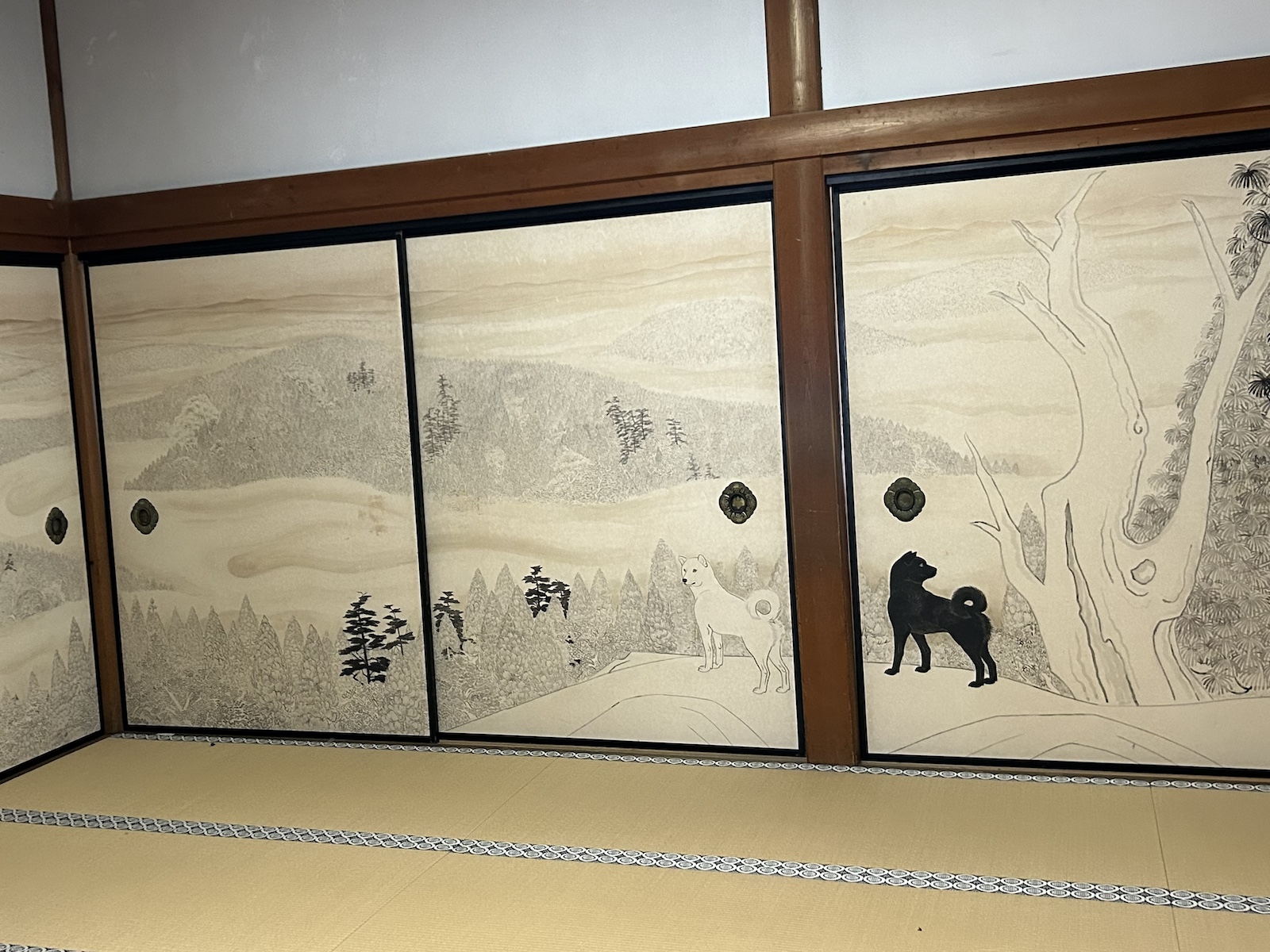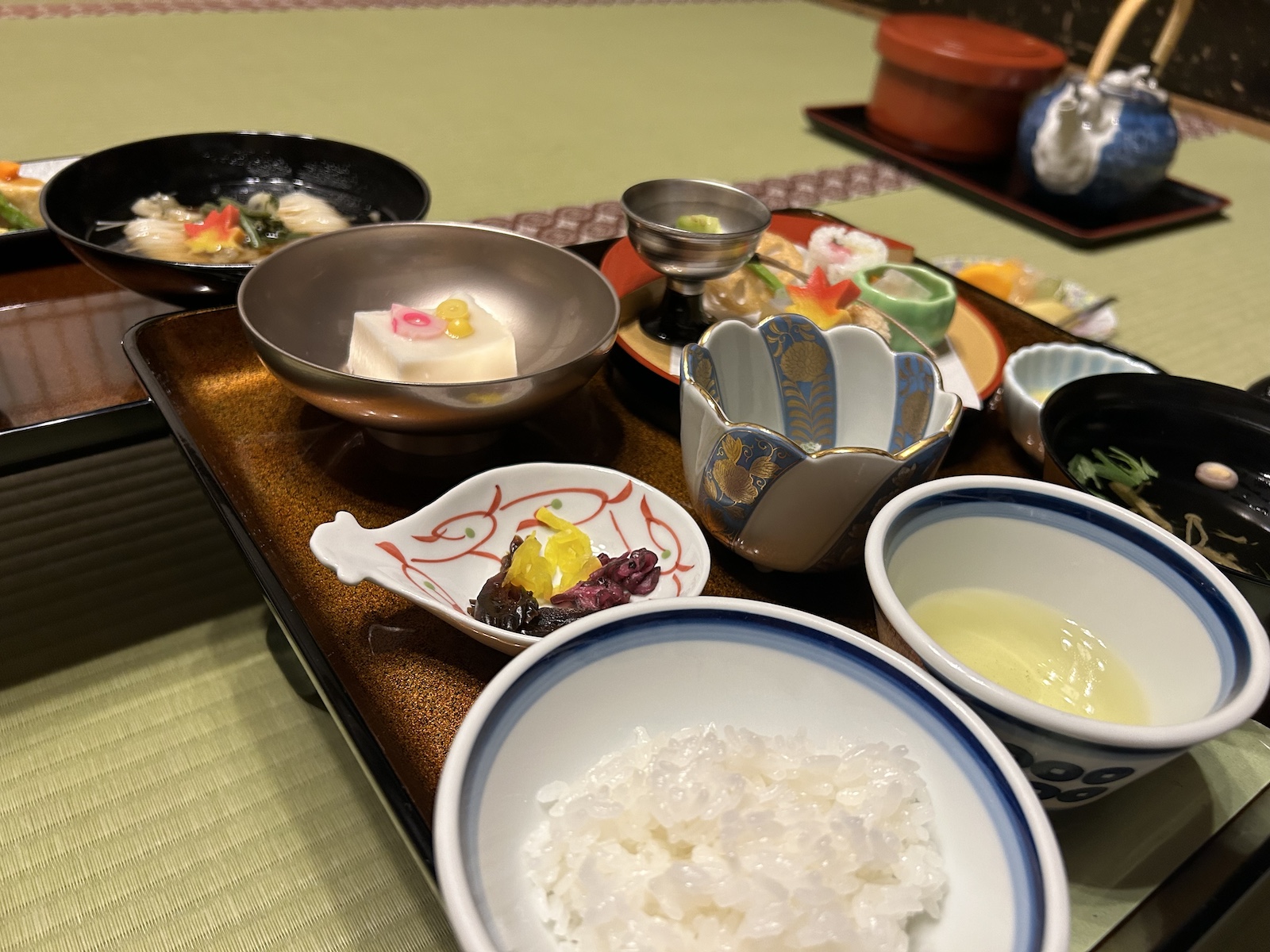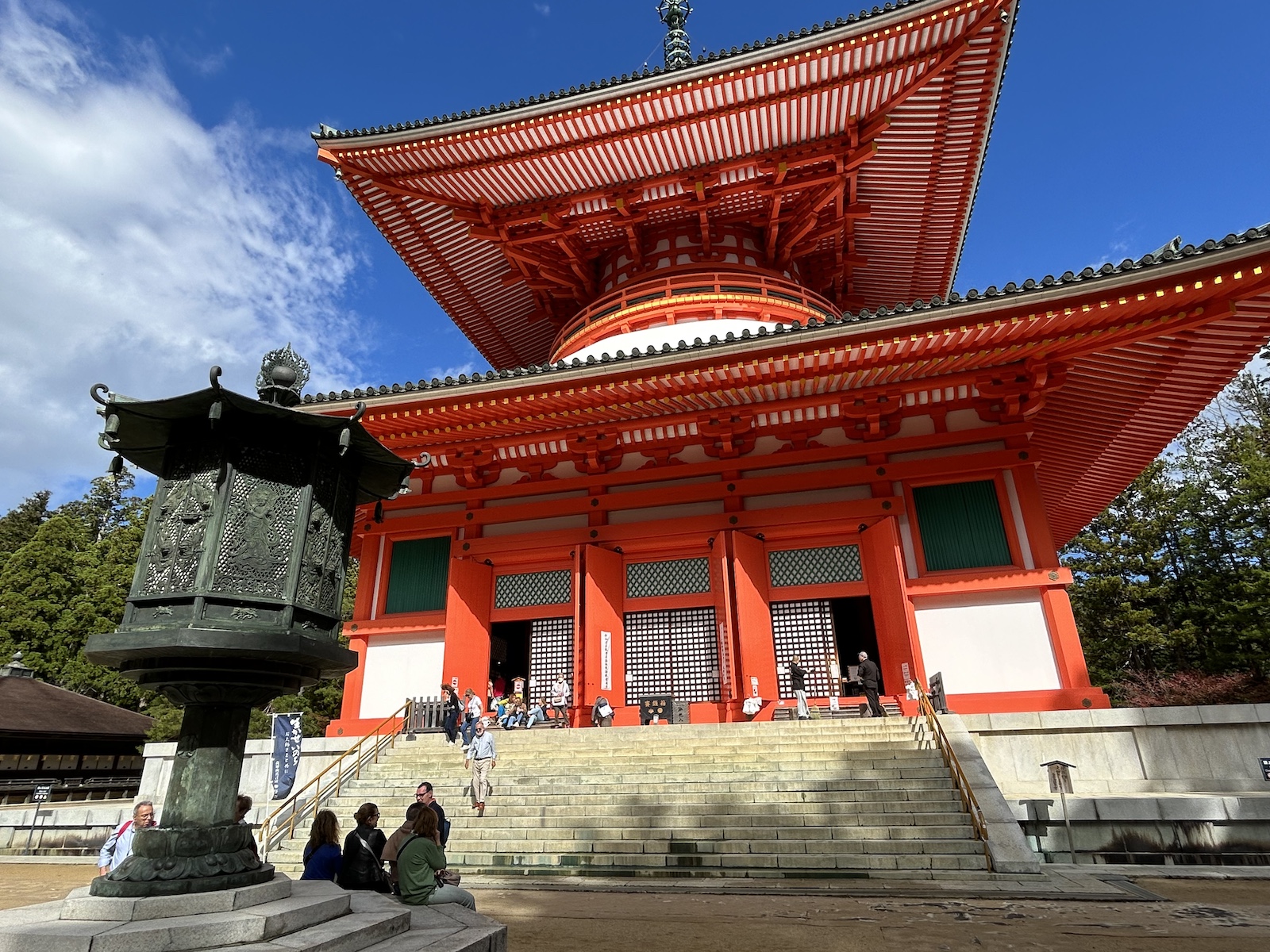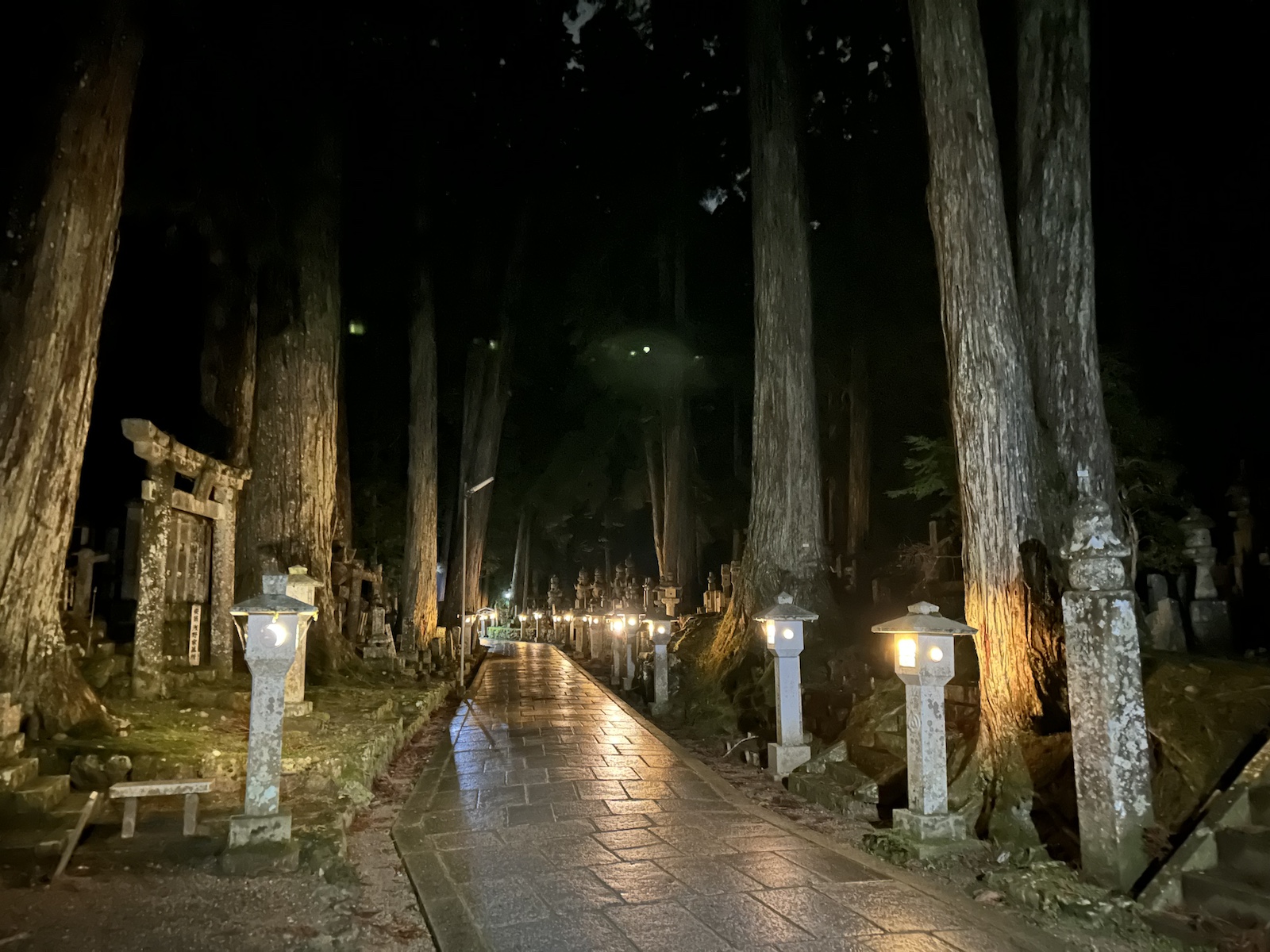Deep in the mountains of northern Wakayama Prefecture, nestled in stately tall trees, sits one of the most important Buddhist sites of Japan: Koyasan. What began as a Buddhist training center 12 centuries ago continues its vital religious functions, while also offering secular visitors the opportunity to experience its peaceful serenity and engage in self-reflection.
In 816 AD, the Buddhist priest Kukai (774–835 AD, known posthumously as Kobo Daishi) founded this center for Buddhist learning and meditation. He had been guided to a sacred site by two dogs, one white, the other black, messengers of two Shinto gods. The area, now popularly known as Koyasan, is a high plain surrounded by eight peaks, interpreted by Kukai to be the eight petals of a lotus flower. In 2004, it was registered as a UNESCO World Heritage site.

Kukai, a Buddhist monk since age 20, was appointed the Eighth Patriarch of Esoteric Buddhism during two years of study in China a decade before founding Koyasan. It was to Esoteric Buddhism, known in Japan as Shingon Buddhism, that he wanted to dedicate Koyasan’s mountain fastness. At the same time, even Buddhists respected Shinto gods, making it natural to accept that Shinto gods brought Kukai to this mountain location.
Shukubo Temple Stay
From its earliest days, Koyasan was a popular destination for pilgrims wishing to deepen their understanding of Buddha’s profound teachings or gain merit during this lifetime to prepare them for the next. Monks and lay people alike traveled to the mountaintop to spend time meditating and worshipping surrounded by nature’s majesty.
There were once as many as 2,000 temples on Koyasan. Many of them provided lodging to pilgrims, a practice known as shukubo. Today, 51 of the 117 remaining temples still provide shukubo accommodation for travelers. Staying in a temple is an essential part of any visit to Koyasan.

The shukubo accommodation provided at temples can vary widely, but is essentially like staying in a traditional minshuku or ryokan. Sleeping quarters are almost always traditional Japanese rooms with tatami flooring and futon bedding, but can range from very basic rooms to luxury suites. Bath/toilet facilities may be ensuite or communal. At a minimum, breakfast will be included, although most shukubo at Koyasan also include an evening meal. Inevitably the meals are shojin ryori, vegetarian meals that adhere to the ancient Buddhist tenets of harming no creatures.
Part of the Koyasan shukubo experience is attending and/or participating in meditation sessions or traditional morning worship at which the temple’s monks chant sutras and offer prayers. Some temples even have English-speaking monks who are prepared to explain the services.

Many temples have listed their shukubo on web-based booking sites. It is also possible to contact the Koyasan Shukubo Association (phone: +81-736-56-2616) for assistance. Note that some temples may not accept credit cards.
Daimon and the Danjo Garan Complex
Visits to Koyasan often begin from Daimon, the great gate that marks out the western entrance to the area. The present two-story gate was built in 1705 and contains statues of two fierce Diva King guardians.

A little over half a kilometer inside the gate, down a road that looks like the entrance to any mountain town, is Danjo Garan, the original complex planned by Kukai. Although the site is the most ancient in Koyasan, the buildings have been destroyed by fire and rebuilt six times over the centuries. Most of the current structures are about a hundred years old.
Immediately inside the Chumon gate, with its four guardian statues, stands the Kondo worship hall, where many of the most important services are held. Towering behind it is Konpon Daito, a massive stupa painted vermillion and white. The statues and painted pillars inside are intended as a three-dimensional rendering of a mandala, while portraits on the four corners of the building depict the eight patriarchs of Shingon Buddhism. Kobo Daishi’s portrait is in the northeast corner, protecting the building and the complex.

On the western boundary of Danjo Garan stands two Shinto shrines, honoring the two gods whose guardian dogs guided Kukai to this sacred spot. Many monks begin their day or any special worship service by paying their respects here.
It is inspirational to explore this vast complex. At night, Konpon Daito is floodlit and the many stone lanterns across the complex create an especially mystical atmosphere.
Kongobuji
A short distance to the east from Danjo Garan stands Kongobuji, now the administrative head of Koyasan. Kukai had originally given the name Kongobuji to the entire site but as more and more temples were built, the name Kongobuji was assigned to this one temple and the area became known as Koyasan.

The temple is laid out like an ancient palace, with spaces separated into rooms by sliding panels opulently decorated with original works of art. The sliding panels in an annex known as Betsuden depict various scenes from the life of Kukai.
Behind Betsuden is Banryutei, said to be the largest karesansui rock garden in Japan. Visitors lucky enough to visit during a rainstorm will gain a new appreciation of how the raked pebbles depict islands and the waves of the surrounding sea.

Okunoin
At the northeast end of Koyasan is Okunoin, a wooded cemetery/memorial park stretching some two kilometers to Kobo Daishi’s mausoleum, where he is said to lie in eternal meditation fulfilling his vow to free people from suffering. The mausoleum is fronted by Torodo, a lantern hall/prayer chapel. The final 100-meter approach, after crossing a sacred bridge over the Tamagawa river, is so holy that no photography is permitted.
Twice a day, at 6 a.m. and 10:30 a.m., monks in traditional saffron robes emerge from the Gokusho Offering Hall on the south side of the river, carrying a karabitsu palanquin containing a meal for Kobo Daishi, refreshments for him during his meditations. They stop to bow before crossing the sacred bridge and then briskly proceed to make their delivery.

There are said to be as many as 200,000 graves in Okunoin, commemorating famous historical figures and common people across the ages since Kobo Daishi’s mausoleum was first established. This makes it one of the largest cemeteries in the world, although many of the so-called graves are merely memorial markers for people whose actual graves are elsewhere, but wished, at least in spirit, to be close to Kobo Daishi in his eternal meditation. Some graves are communal, sponsored by corporations in memory of their founders or workers who lost their lives on the job, or in memory of military troops (both friend and foe) lost in battles over the centuries.

Nyonindo
Until 1872, women were not permitted within the precincts of Koyasan. Those women who chose to make the pilgrimage, were permitted only as far as the entrances, at which there were buildings known as Nyonindo, where they could worship and find accommodation. While there were once seven Nyonindo, today only the one at the northwest entrance remains.

Instead of entering Koyasan, women pilgrims would circumnavigate the area on mountain trails while engaging in meditation. Those trails still exist and are popular with hiking enthusiasts.
The Gomataki Fire Ritual
A uniquely Shingon Buddhist rite performed regularly at Koyasan is Gomataki. This is a fire ritual during which prayer sticks prepared by worshipers are consigned to flames tended by a monk. The flames are believed to symbolize the wisdom of Buddha. When the prayer sticks are burned, the prayers are sent heavenward while simultaneously cleansing the soul of the supplicant.
This ritual is performed at different Koyasan temples at different times and with different frequency. At Shojoshin-in, near the entrance to Okunoin, it is performed daily at 1 p.m.

Getting There
Koyasan’s remote mountain location makes it somewhat difficult to reach. It is a 95-minute journey from Osaka’s Nankai Namba station to Gokurakubashi station. From there it is a 5-minute cable car trip to Koyasan station. A shuttle bus then takes visitors into Koyasan itself. There is also an express bus from Kyoto, but it does not run during the winter months as snow can make roads impassable.
Vicki L Beyer, a regular Japan Today contributor, is a freelance travel writer who also blogs about experiencing Japan. Follow her blog at jigsaw-japan.com. The author wishes to thank the Wakayama Tourism Federation for hosting her visit.
© Japan Today Get your ticket to GaijinPot Expo 2024
Get your ticket to GaijinPot Expo 2024















No Comment
Login to comment